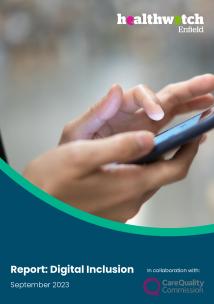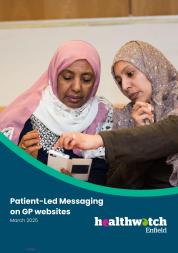Understanding Digital Exclusion: key findings and full report

In March 2023, Healthwatch Enfield collaborated with the Care Quality Commission (CQC) to understand the reasons behind digital exclusion with specific community groups by exploring how individuals share their feedback about health and social care services.
Our investigation sought to understand their access to digital devices, feedback sharing patterns, and their awareness and expectations of the CQC.
Who took part?
We sent out surveys and held engagement groups to explore the reasons behind digital exclusion.
From April – August 2023 we connected with:
- 116 people took part in our survey on digital exclusion, service feedback, and the CQC
- 86 took part in community engagement sessions
- 30 took part in a general survey
Key Findings
- A variety of barriers to digital access and people's ability to provide feedback. They range from language and sensory challenges to mistrust and past negative experiences. The barriers are not only technical but also psychological and economic, with notable differences across groups such as those with disabilities, the elderly, English for Speakers of other Languages (ESOL) participants, and refugees.
- Each demographic, such as people with disabilities, ESOL learners, and mental health group participants, faces unique obstacles that prevent them from fully engaging with digital services or providing feedback. These include reliance on others for communication, deep-rooted distrust in authorities, and a pervasive belief amongst some that their feedback will not lead to change.
- Despite a general preference for digital feedback methods such as email or text in survey responses, community engagement sessions revealed a preference for more personal interaction, like phone calls or face-to-face meetings, highlighting a gap between assumed and actual preferred communication methods.
- Over half (57%) of general survey respondents are aware of the CQC, suggesting that while there is some level of awareness, a significant portion of the population is not informed about the regulatory body or its role.
- Across all groups, there is a strong emphasis on the importance of receiving a response or acknowledgement after providing feedback. Despite varying levels of apathy, there remains a subset of individuals who are motivated to provide feedback by a desire to be heard, to seek redress, or to contribute to service improvement.
Our findings highlight interlinking social, economic, and personal factors that affect how different groups interact with digital services and regulatory bodies, and the need for inclusive, responsive, and varied approaches to giving feedback.
If you have any questions about this report, please email admin@healthwatchenfield.co.uk.

